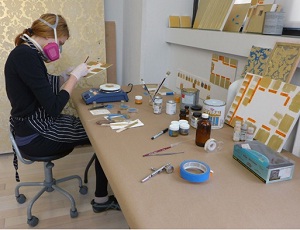Marie Curie funding to develop contemporary art conservation research
Published: 13 April 2015
Funding will educate a new generation of curators, conservators and academic researchers to develop new ways of conserving and restoring contemporary artworks.
The University of Glasgow has secured funding to educate a new generation of curators, conservators and academic researchers to develop new ways of conserving and restoring contemporary artworks.
Dr Erma Hermens, from the University of Glasgow, received €510,000 as one of nine partners in six European countries making up a Marie Curie Initial Training Network on Contemporary Art Conservation Research. The consortium will oversee the training of 10 PhD students who will work on projects addressing fundamental questions concerning the identity, values and authenticity of modern and contemporary artworks and the consequences for their conservation and curation.
 Increasingly, contemporary artists employ unusual and non-durable materials as well as technologies that become rapidly outdated and obsolete, posing huge challenges for conservators and curators alike. There is also a growing demand for new ways to record more ephemeral and experimental forms such as conceptual art, happenings, performances, multimedia installations, and new media art.
Increasingly, contemporary artists employ unusual and non-durable materials as well as technologies that become rapidly outdated and obsolete, posing huge challenges for conservators and curators alike. There is also a growing demand for new ways to record more ephemeral and experimental forms such as conceptual art, happenings, performances, multimedia installations, and new media art.
Dr Erma Hermens, Lord Kelvin Adam Smith Senior Lecturer in Technical Art History, says: “A major problem for the conservation of contemporary art is that traditional conservation methods don’t really answer the problems posed by the complex materials used and their often conceptual, ephemeral, dynamic and performative character.
“This funding brings together universities, museums, and conservation institutions and studios from around Europe and the United States, to develop a consistent strategy and body of knowledge when it comes to contemporary art conservation research. We are very pleased that the University of Glasgow is at the forefront of this important emerging area and look forward to working with our partners.”
The University of Glasgow will work alongside eight partner organisations in the network: Maastricht University, University of Amsterdam, Tate London, Universidade Nova de Lisboa, University of Porto and Cologne University of Applied Sciences, Museo delle Culture, Milan, University of Roma III, and the Academy of Fine Arts, Warsaw.
One of the Glasgow-based PhDs will have the unique opportunity to work for six months in New York City with Christian Scheidemann, director of Contemporary Conservation Ltd, one of the very few private studios exclusively specializing in contemporary art conservation.
Christian Scheidemann said: “The new Marie Curie network is an important instrument and platform to research strategies for maintaining the physical and intellectual integrity and historic value of contemporary art. The challenge for the conservator lies in acknowledging all these factors, finding a way to restore these works made of non-durable materials and to educate people involved about the complex sensitive nature of contemporary art.”
Media enquiries: nick.wade@glasgow.ac.uk
Notes to editors:
- Scheidemann describes an example of a complex technical problem that studio is dealing with concerning the restoration of a piece of contemporary art: “For example, this work by Rudolf Stingel is a painting executed seemingly in traditional techniques on canvas but with the use of appliance gold paint for indoor decoration (household gold paint instead of gold leaf). The pattern is created from store-bought tulle and decorative fabrics. The challenge here is that the use of industrial metal paint in the realm of fine arts poses new approaches in handling artworks that look stable - but in reality are not. Gold leaf does not oxidize, but this industrial paint does. The touch of a finger or palm speeds that process up and can destroy the market value of the artwork. Here you see one of our conservators spending a couple of weeks (paid!) just to find out how to imitate the now tarnished surface of the original paint. We collaborate with the artist who provided us with a can of the original paint but, of course, it did not match because the paint changes more on the painting than inside the paint can. Through the exposure to heat we were able to achieve the desired match for the original appearance. We now found a metal paint company that is willing to mix the exact tone of gold and we can use a medium to in paint this newly matched paint onto the oxidized areas of fingerprints.”
First published: 13 April 2015
<< April

